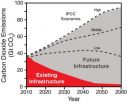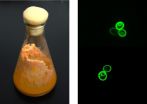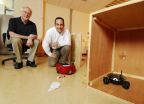(Press-News.org) Stanford, CA— Scientists have warned that avoiding dangerous climate change this century will require steep cuts in carbon dioxide emissions. New energy-efficient or carbon-free technologies can help, but what about the power plants, cars, trucks, and other fossil-fuel-burning devices already in operation? Unless forced into early retirement, they will emit carbon dioxide into the atmosphere for decades to come. Will their emissions push carbon dioxide levels beyond prescribed limits, regardless of what we build next? Is there already too much inertia in the system to curb climate change?
Not just yet, say scientists Steven Davis and Ken Caldeira of the Carnegie Institution's Department of Global Ecology. But to avoid the worst impacts we need to get busy building the next generation of clean energy technologies.
Davis and Caldeira, with colleague Damon Matthews of Concordia University in Montreal, calculated the amount of carbon dioxide expected to be released from existing energy infrastructure worldwide, and then used a global climate model to project its effect on the Earth's atmosphere and climate.
"The problem of climate change has tremendous inertia," says Davis. "Some of this inertia relates to the natural carbon cycle, but there is also inertia in the manmade infrastructure that emits CO2 and other greenhouse gases. We asked a hypothetical question: what if we never built another CO2-emitting device, but the ones already in existence lived out their normal lives?"
For a coal-fired power plant a "normal life" is about 40 years. For a late-model passenger vehicle in the United States it is about 17 years. After compiling data on lifetimes and emissions rates for the full range of fossil-fuel burning devices worldwide, the researchers found that that between the years 2010 to 2060 the total projected emissions would amount to about 500 billion tons of carbon dioxide added to the atmosphere. To gauge the impact, they turned to the climate model. The researchers found that atmospheric concentrations of CO2 would stabilize at less than 430 parts per million (ppm) and the increase of global mean temperatures since preindustrial time would be less than 1.3°C (2.3°F).
"The answer surprised us," says Davis. "Going into this study, we thought that existing sources of CO2 emissions would be enough to push us beyond 450 ppm and 2°C warming." In light of common benchmarks of 450 ppm and 2°C, these results indicate that the devices whose emissions will cause the worst impacts have yet to be built.
But the authors caution that while existing infrastructure is less of a threat to climate than they had expected, this does not minimize the threat of future emissions. "Because most of the threat from climate change will come from energy infrastructure we have yet to build, it is critically important that we build the right stuff now – that is, low carbon emission energy technologies," says Caldeira. He adds that other factors besides devices that directly emit carbon dioxide might also contribute to the system's inertia. "We have a gas station infrastructure but not a battery recharging infrastructure," he says. "This makes it easier to sell new gasoline powered cars than new electric cars. Thus there are infrastructural commitments that go beyond our calculation of future CO2 emissions embodied in existing devices."
"In our earlier work we found that every increment of carbon dioxide emission produces another increment of warming," says Caldeira. "We cannot be complacent just because we haven't yet reached a point of no return."
The study is published in the September 10, 2010, issue of Science.
INFORMATION:
The Carnegie Institution for Science (carnegiescience.edu) is a private, nonprofit organization headquartered in Washington, D.C., with six research departments throughout the U.S. Since its founding in 1902, the Carnegie Institution has been a pioneering force in basic scientific research. Carnegie scientists are leaders in plant biology, developmental biology, astronomy, materials science, global ecology, and Earth and planetary science.
The Department of Global Ecology was established in 2002 to help build the scientific foundations for a sustainable future. The department is located on the campus of Stanford University but is an independent research organization funded by the Carnegie Institution. Its scientists conduct basic research on a wide range of large-scale environmental issues, including climate change, ocean acidification, biological invasions, and changes in biodiversity.
Main climate threat from CO2 sources yet to be built
2010-09-09
ELSE PRESS RELEASES FROM THIS DATE:
Study finds the effects of population aging have been exaggerated
2010-09-09
Laxenburg, Austria – 9th September 2010. Due to increasing life-spans and improved health many populations are 'aging' more slowly than conventional measures indicate.
In a new study, to be published in Science, (10 September) scientists from the International Institute for Applied Systems Analysis (IIASA) in Austria, Stony Brook University, US, (SBU), and the Vienna Institute of Demography (VID) have developed new measures of aging that take changes in disability status and longevity into account.
The results give policymakers faced with growing numbers of elderly ...
Energy technologies not enough to sufficiently reduce carbon emissions, NYU's Hoffert concludes
2010-09-09
Current energy technologies are not enough to reduce carbon emissions to a level needed to lower the risks associated with climate change, New York University physicist Martin Hoffert concludes in an essay in the latest issue of the journal Science.
Many scientists have determined that in order to avoid the risks brought about by climate change, steps must be taken to prevent the mean global temperature from rising by more than 2°C above pre-industrial levels. Current climate models indicate that achieving this goal will require limiting atmospheric carbon dioxide (CO2) ...
In order to save biodiversity society's behavior must change, leading conservationists warn
2010-09-09
An innovative grouping of conservation scientists and practitioners have come together to advocate a fundamental shift in the way we view biodiversity. In their paper, which was published today in the journal Science, they argue that unless people recognise the link between their consumption choices and biodiversity loss, the diversity of life on Earth will continue to decline.
Dr Mike Rands, Director of the Cambridge Conservation Initiative and lead author of the paper, said: "Despite increasing worldwide conservation efforts, biodiversity continues to decline. If ...
Global health vs. global wealth: Looming choice for health firms in developing countries
2010-09-09
The lure of greater profits elsewhere in the world may divert bio-pharmaceutical firms in developing countries from the creation and distribution of affordable drugs, vaccines and diagnostics for illnesses of local concern, undermining the health prospects of millions of poor people, experts warn.
And they call for a series of measures to bolster international support for continuing the success of firms finding homegrown solutions to immediate health concerns in developing countries.
In a commentary published by the journal Nature Biotechnology, researchers Rahim Rezaie ...
Researchers expand yeast's sugary diet to include plant fiber
2010-09-09
University of California, Berkeley, researchers have taken genes from grass-eating fungi and stuffed them into yeast, creating strains that produce alcohol from tough plant material – cellulose – that normal yeast can't digest.
The feat could be a boon for the biofuels industry, which is struggling to make cellulosic ethanol – ethanol from plant fiber, not just cornstarch or sugar – economically feasible.
"By adding these genes to yeast, we have created strains that grow better on plant material than does wild yeast, which eats only glucose or sucrose," said Jamie Cate, ...
Greener pastures and better breeds could reduce carbon 'hoofprint'
2010-09-09
NAIROBI (9 September 2010)—Greenhouse gas emissions caused by livestock operations in tropical countries—a major contributor to climate change—could be cut significantly by changing diets and breeds and improving degraded lands, according to a new study published this week in the U.S. Proceedings of the National Academy of Sciences. And as an added bonus, scientists found the small changes in production practices could provide a big payoff by providing poor farmers with up to US$1.3 billion annually in payments for carbon offsets.
"These technologically straightforward ...
Phoenix Mars Lander finds surprises about red planet's watery past
2010-09-09
Liquid water has interacted with the Martian surface throughout Mars' history, measurements by NASA's Phoenix Mars Lander suggest.
The findings, published in the Sept. 10 issue of the journal Science, also suggest that liquid water has primarily existed at temperatures near freezing, implying hydrothermal systems similar to Yellowstone's hot springs on Earth have been rare on Mars throughout its history.
These surprising results come from measurements Phoenix made in 2008 of stable isotopes of carbon and oxygen in the carbon dioxide of the Martian atmosphere. Isotopes ...
The pros and cons of Miscanthus -- uses more water, leaches less nitrogen
2010-09-09
URBANA – In the search for the perfect crop for biofuel production, Miscanthus has become the darling to many. But in an effort to not be charmed by its enormous potential for biomass production, researchers at the University of Illinois are taking a careful look at the pros and cons of its behavior in the field.
A recent study analyzed water quantity and quality in plots of Miscanthus, switchgrass, corn, and soybeans and found that Miscanthus used substantially more water, but reduced the potential for nitrogen pollution to water bodies.
"We found that Miscanthus ...
Researchers give robots the capability for deceptive behavior
2010-09-09
A robot deceives an enemy soldier by creating a false trail and hiding so that it will not be caught. While this sounds like a scene from one of the Terminator movies, it's actually the scenario of an experiment conducted by researchers at the Georgia Institute of Technology as part of what is believed to be the first detailed examination of robot deception.
"We have developed algorithms that allow a robot to determine whether it should deceive a human or other intelligent machine and we have designed techniques that help the robot select the best deceptive strategy to ...
Overweight and obese make up majority in Ontario
2010-09-09
OTTAWA – September 9, 2010 --- New analysis of a landmark health survey by the University of Ottawa Heart Institute (UOHI) shows that 70% of Ontario adults are either overweight or obese, and have a strong prevalence of high blood pressure that could lead to heart attack or stroke.
The research, led by Dr. Frans Leenen of the Heart Institute's Hypertension Unit, adds new information to a limited amount of Canadian data on obesity and high blood pressure. The analysis further strengthens the link between high blood pressure and above normal Body Mass Index (BMI), a formula ...





